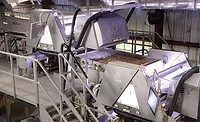USDA Automates In-House Media, Making for Flexibility and Reliability

The U.S. Department of Agriculture Food Safety and Inspection Service (USDA-FSIS) is the public health agency responsible for ensuring that the nation’s commercial supply of meat, poultry and egg products is safe. The USDA-FSIS facility in Alameda, CA, tests meat, poultry and eggs produced by factories across the country. They regulate foods such as ham, hotdogs and any type of cooked or ready-to-eat material. These products are tested for the main human pathogens: Salmonella, Escherichia coli, Listeria and E. coli O157:H7. The USDA-FSIS Alameda’s Western Laboratory has been using Systec MediaPrepTM automated media sterilizers since 2004 for all its media-making needs.
They are producing large quantities of buffered peptone water (BPW) and tryptic soy broth (TSB) enrichment broths. MediaPrep is a fully automated system for media sterilization and dispensing, with active cooling to provide fast cycle times for busy laboratories. It is available in seven sizes, ranging from 10 L to 120 L. The USDA Western Lab has one MediaPrep 10, three MediaPrep 120s and one MediaFillTM automated plate pourer. Pairing the MediaFill with the MediaPrep allows maximum flexibility for creating diluent and agar plates as quickly as needed. Microbiology International recently sat down with Brooks Wong, supervisor of the microbiology department of the USDA-FSIS’s Alameda laboratory to discuss the use of the MediaPrep and MediaFill systems and how the equipment has affected its daily process.
Microbiology International (MI): In what way does the microbiology lab use both of these instruments to carry out daily operations at the USDA-FSIS?
Brooks Wong (BW): We use several types of media in our operations, so it is key to have different instruments available to make different media at the same time. For instance, we use very high volumes of BPW and high volumes of TSB broth.
MI: You mentioned BPW and TSB, but can you tell me what kind of liquid media types you make, roughly what those volumes are and why such high volumes?
BW: The main media we make in high volume are BPW and TSB. We will make 100 L at a time, so we utilize the MediaPrep 120s; and we make about 500 L a week of each. Our sample is a 1 to 10 dilution. A typical sample we cut up from the factory is 350 g; so a 1:10 is 3 L. We use a lot! And we’ll get maybe 37,000 samples a year. You can imagine how much media we use here at the Western Laboratory.
MI: How has using the MediaPrep system benefited your day-to-day operations?
BW: If there is any critical need for the BPW or TSB, or need for use of the MediaFill, we can usually get that out in a 4-hour window and test with it the next day. So it is very flexible for us. We have a regular schedule of production, of course, but if there is a high-volume week and we use too much BPW or TSB, we can increase one or the other in an instant.
MI: How has the MediaFill Plate Pourer benefited your daily operations?
BW: We can produce different types of media for plates right away instead of trying to order from an outside vendor. It gives us a lot of flexibility of time. Instead of waiting for an ordered case of plated DLMA, for example, we can go ahead and just utilize the smaller MediaPrep 10 and MediaFill Plate Pourer and get our product out in 3 to 4 hours and ready to run. We are also using the 100×15-mm MediaPro plates from Microbiology International and they run very smoothly in the MediaFill.
MI: Why did you choose the Systec MediaPrep and MediaFill equipment over the competitive system available?
BW: It’s an economical system. It allows us to buy media in bulk. The system works very well for us in that regard. It is easy to use and reliable.
MI: What is your overall impression of the support and service of Microbiology International, which distributes this equipment?
BW: We have a service contract with Microbiology International. If we have a problem, we call in and the service rep for Microbiology International arrives in a timely manner. He assesses the problem and gets our user input to discern what is going on. He knows the instruments inside out. He recommends solutions, orders parts and fixes the units to get us back on our feet quickly.
MI: Would you purchase additional units if the need arose and would you recommend these units to other facilities?
BW: Currently, we have an MP 10, two MP 120s and a MediaFill already in operation. We have already ordered and received an additional MP120 that we will install at our new facility. So we will have a total of three MP 120s ready for action. I would absolutely recommend these units to other facilities. We are one of three USDA-FSIS labs and I always recommend these systems to my other two labs. My other two labs each have at least one MP 120 in operation from Microbiology International. www.800ezmicro.com
Looking for quick answers on food safety topics?
Try Ask FSM, our new smart AI search tool.
Ask FSM →








